Heritage of Egypt | |
| 123Independenceday » Egypt » Heritage | |
| |
|


Heritage of Egypt | |
| 123Independenceday » Egypt » Heritage | |
| |
|

Economy, Egypt |
| 123Independenceday » Egypt » Economy |
| Occupying the north-east corner of the African continent, Egypt is bisected by the highly fertile Nile Valley, where most economic goings-on take place. The Egyptian economy mainly depends on agriculture, media, petroleum exports, textiles and tourism. The completion of the Aswan High Dam in 1971 and the resulting Lake Nasser have altered the age-old place of the Nile River in the agriculture and ecology of Egypt. It's abhorrently overpopulated, and there is neither sufficient agricultural land, nor water resources to uphold the ever increasing population currently estimated at about 70 million, which persist to overtax resources and stress the economy. A chain of International Monetary Fund arrangements, together with massive external debt relief resulting from Egypt's involvement in the Gulf War alliance, helped Egypt improve its macro-economic performance during the 1990s. Egypt is mainly dependent upon foreign aid, and remittances from citizens working abroad in oil-rich countries. There are more than 3 million Egyptians working abroad, mainly in Saudi Arabia, the Persian Gulf and Europe. |
Egypt's effort to industrialize the country started in the 19th century, under Muhammed Ali, the then ruler. Though machines and technology were imported, often at a high cost, local industries gradually developed and by World War 1, textile industries had gained a strong foothold. At present, Egypt's industries include the production of cement, iron and steel, chemicals, fertilizers, tobacco, canned foods, rubber products, refined sugar, cottonseed oil, small metal products, shoes and furniture. Mining has also emerged as a vital industry in the last 20 years with products like crude petroleum, salt, phosphate, iron and manganese. In the last 30 years a lot of reformation has been made to the highly centralized economy inherited from President Nasser. Though the rate of structural reforms, for instance privatization and new business legislation, has been slower than the IMF envisioned, Egypt's steps toward a more market-oriented economy have encouraged increased foreign investment. It has made substantial progress in growing its legal, tax and investment infrastructure. In 2005 personal, corporate tax rates and energy subsides were reduced and several enterprises privatized by Prime Minister Ahmed Nazif. Egypt has been rated as one of the top countries in the world undertaking economic reforms by the IMF in their annual report. Some of the steps taken by the government include a dramatic slashing of customs and tariffs, a new taxation law implemented in 2005 that decreases corporate taxes from 40% to the current 20%, resulted to the stated 100% increase in tax revenue by the year 2006. Foreign Direct Investment into Egypt has also increased considerably in the past few years making Egypt the highest earner of FDI on the African continent in 2008. The stock market boomed, with the GDP rising about 5% per year in 2005-06. Even with these achievements, the government has failed to raise the standard of living for the average Egyptians, and has had to continue providing subsidies for basic necessities.
|



 |  HUD camera photo from the MiG-21 that shot down an intruding Pakistan Navy reconnaissance plane. The missile is seen rushing to the port engine of the Atlantique. HUD camera photo from the MiG-21 that shot down an intruding Pakistan Navy reconnaissance plane. The missile is seen rushing to the port engine of the Atlantique. Courtsey Bharat Rakshak |
 | Video grab of IAF personnel salvaging the wreckage on cover of Outlook magazine. |
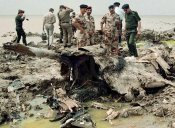 | A group of Pakistan-based foreign military attaches in Badin August 12 inspect the site where a Pakistan naval plane crashed after being shot down by Indian jet fighters. Pakistan took the attaches to the site of the August 10 crash to try to prove its claim the plane was shot down in Pakistani territory. REUTERS © corbis.com |
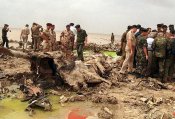 | Foreign diplomats view the wreckage of a Pakistan navy Atlantic patrol aircraft 12 August, 1999, in Musafirkhana, Pakistan. Military attaches from embassies of 28 countries, including the United States, Britain, Canada, Germany and France, flew to the site where the Indian fighter jets shot down a Pakistan navy aircraft 10 August. AFP PHOTO © corbis.com |
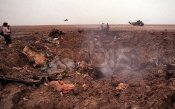 | Reporters and military personnel stand by the crash site of a Pakistan's Breguet Atlantic maritime patrol aircraft near the border town of Badin, about 300 kilometers northeast of Karachi, 10 August 1999. Two Pakistan Navy Seakings are visible in the background. AFP PHOTO/Farroq AHMED © corbis.com |
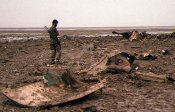 | A Pakistani soldier walks near the wreckage of a Naval patrol aircraft, which was shot down by Indian jets 10 August, 1999, near Badin, some 300km (186 miles) northeast of Karachi. The Indian Air Force shot down the Breguet Atlantic maritime patrol aircraft, killing all 16 Navy personnels on board. AFP PHOTO/Farooq AHMED © corbis.com |
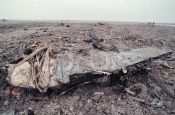 | The wreckage of a Pakistani naval surveillance plane smolders after it was shot down August 10 by an Indian fighter jet. An Indian combat jet shot down a maritime patrol aircraft, prompting a threat of retaliation from Islamabad which said all 16 people on board were killed Photo by Zahid Hussein © Reuters/CORBIS |
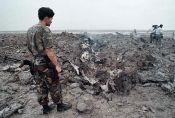 | Pakistani soldier, near the Indian border, looks at the wreckage of a Pakistan naval surveillance plane which was shot down August 10 by an Indian fighter. An Indian combat jet shot down the maritime patrol aircraft on Tuesday, prompting a threat of retaliation from Islamabad which said all 16 people on board were killed Photo by Zahid Hussein © Reuters/CORBIS |
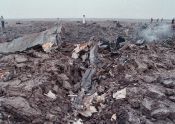 | Pakistani naval surveillance plane burns after it was shot down August 10 by an Indian fighter. An Indian combat jet shot down a maritime patrol aircraft, prompting a threat of retaliation from Islamabad which said all 16 people on board were killed Photo by Zahid Hussein © Reuters/CORBIS |
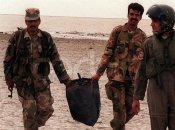 | Pakistani troops take away a bag containing body remains of personnels killed in the naval plane downed by Indian jets near the site of wreckage in Mushafir Khana, close to the border with India, 11 August 1999. Pakistan deployed some 200 naval and army troops at the site of the wreckage to avoid the removals of plane pieces by Indian air force. AFP PHOTO/Aamir Qureshi © corbis.com |
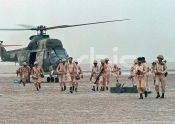 | Pakistan soldiers take control of naval plane crash site August 11. Pakisatan has placed about 200 soldiers armed with missiles around the crashed plane which was shot down by India on Tuesday killing all 16 people onboard Photo by Zahid Hussein © Reuters/CORBIS (Note Pakistan Army Puma helicopter) |
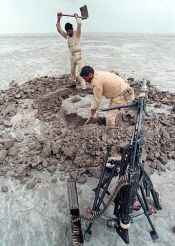 | Pakistani soliders dig in to prepare a machine-gun nest at the site August 11 where a naval plane crashed after it was hit by an Indian missile on Tuesday. Pakisatan has placed about 200 soldiers some armed with missiles around the crashed site Photo by Zahid Hussein © Reuters/CORBIS (This is actually a air defence position. The MMG would be positioned in the middle so that the operator can pivot around in all directions in the circular 'trench') |
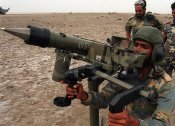 | A Pakistan army soldier adjusts a Mistral surface-to-air missile near the site of the wreckage of a naval plane downed by Indian jets in Mushafir Khana, near the border with India, 11 August 1999. Some 200 navy and army troops were manning the area, equipped with machine guns and missiles, as charred pieces of the aircraft were scattered in marshy land over a radius of about 1.6 kilometers. AFP PHOTO/Aamir Qureshi © corbis.com |
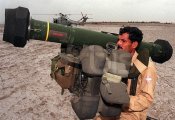 | A Pakistan army soldier takes position with a RBS-70 surface-to-air missile launcher near the site of the wreckage of a naval aircraft, which was shot down by Indian jets 10 August, in Mushafir Khana close to border with India, 11 August 1999. Pakistan has reinforced its troops deployed in the marshy border area supposedly to prevent any Indian attempts to steal debris. AFP PHOTO/Aamir QURESHI © corbis.com |
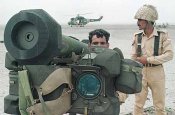 | Another view of the RBS-70 position. A Pakistan Army Puma helicopter is stationary in the background. |
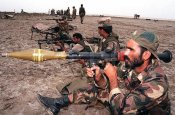 | Pakistani troops take position with LMGs and RPGs close to the site of the wreckage of a downed Pakistani naval patrol plane shot down by Indian jets in Musafir Khana, close to the Indian border, 11 August 1999. Pakistan fired at least one missile at two Indian jets trying to cross into its territory. Indian jets on 10 August shot downed Pakistan's naval plane and killed 16 personnels. AFP PHOTO © corbis.com |
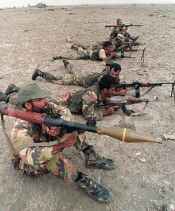 | Pakistani soldiers with RPG and machine guns take their positions August 11 at the site where a Pakistani naval plane was shot down by India on Tuesday. Pakistan has placed around 200 soldiers some armed with missiles at the crash site Photo by Zahid Hussein © Reuters/CORBIS (These guys are possibly Pakistan Navy troops. PN Lynx helicopter in the far background) |
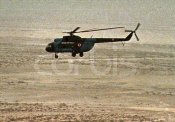 | An Indian Air Force Mi-17 helicopter carring journalists returns to base after surviving a Pakistani missile attack in the Rann of Kutch near the India-Pakistan border August 11. The helicopter was attacked by a shoulder-fired surface-to-air missile during a mission to show journalists the wreckage of a Pakistani aircraft downed by Indian fighters on August 10. REUTERS © corbis.com |
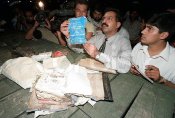 | Indian Air Force (IAF) spokesman R. Dhingra (C) shows documents retrieved from a French-made Breguet Atlantic marine patrol aircraft of the Pakistani Air Force that was shot down by IAF fighters 10 August, as they were displayed at the technical area of Palam airport early 11 August 1999. AFP PHOTO/RAVEENDRAN © corbis.com |
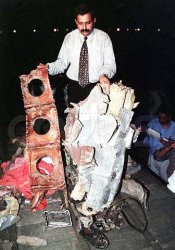 | Indian Air Force (IAF) spokesman R. Dhingra shows wreckage of a French-made Breguet Atlantic marine patrol aircraft of the Pakistani Air Force that was shot down by IAF fighters 10 August, as they were displayed at the technical area of Palam airport early 11 August 1999. AFP PHOTO / RAVEENDRAN © corbis.com |
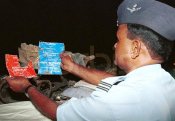 | An IAF officer displays the flight check list of the Pakistani naval aircraft at New Delhi airport on August 11. India said the plane was shot down on August 10 after it intruded into its territory and refused to respond to Indian warnings near the border in Gujarat state. The wreckage was flown to the Indian capital early morning and shown to journalists. Sunil Malhotra REUTERS © corbis.com |
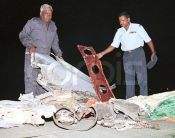 | Indian Air Force personnel display the wreckage of a Pakistani naval aircraft at New Delhi airport August 11. India said the plane was shot down on August 10 after it intruded into its territory and refused to respond to Indian warnings near the border in Gujarat state. The wreckage was flown to the Indian capital early morning and shown to journalists. Photo by Sunil Malhotra © Reuters/CORBIS |
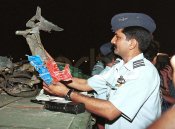 | An IAF officer displays the flight check list and a part of the wreckage of the Pakistani naval aircraft at New Delhi airport on August 11. India said the plane was shot down on August 10 after it intruded into its territory and refused to respond to Indian warnings near the border in Gujarat state. The wreckage was flown to the Indian capital early morning and shown to journalists. Sunil Malhotra REUTERS © corbis.com |
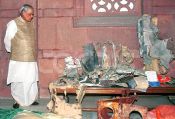 | Indian Prime Minister Atal Behari Vajpayee views the wreckage of the Pakistani naval aircraft at his New Delhi office on August 11. India said the plane was shot down on August 10 after it intruded into its territory and refused to respond to Indian warnings near the border in Gujarat state. The wreckage was flown to the Indian capital early morning. Photo by Sunil Malhotra © Reuters/CORBIS |
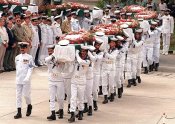 | Pakistani sailors carry the coffins of 16 naval personnel for mass prayers at the Mehran naval base in the port city of Karachi 12 August, 1999. Prime Minister Nawaz Sharif attended the prayers for the sixteen Pakistani naval officers and sailors who were killed when Indian fighter jets fired a missile on the Pakistani patrol aircraft 10 August. AFP PHOTO Aamir QURESHI © corbis.com |
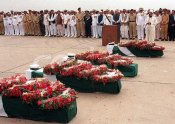 | Dignataries including Pakistani Prime Minister Nawaz Sharif and Pakistan Naval chief Fasih Bukhari pay their respects during mass prayers at Mehran naval base in Karachi 12 August, 1999 for the 16 naval personnel killed when their plane was shot down by India. Six officers and ten sailers were killed when Indian fighter jets fired a missile on a Pakistani patrol aircraft 10 August. AFP PHOTO © corbis.com |
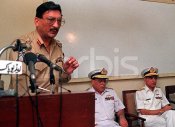 | Pakistan's military spokesman, Brigadier Rashid Qureshi (L), gives the media the Pakistani version of events in the southern port city of Karachi 10 August, 1999. AFP PHOTO/Aamir QURESHI © corbis.com |
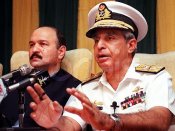 | Pakistan naval officer Admiral Aziz Mirza (R) briefs newsmen along with Information Minister Mushahid Hussain in Islamabad, 11 August 1999. AFP PHOTO/Usman KHAN © corbis.com |
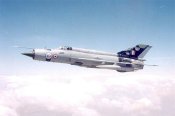 | A MiG-21Bis [C2210] of the No. 45 Flying Daggers Squadron seen in flight in this file photo. The same unit is credited with bringing down the Pakistan Navy Atlantique MPA. Wing Commander Zaki © Bharat Rakshak |
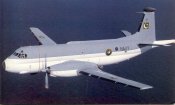 | A Pakistan Navy Br1150 Atlantic [40] operated by the 29 Squadron. One such aircraft [S/N=90, C/N=33] was written off on August 10, 1999. © Peter Steinmann |

 Were secret military spy planes used to find wannabe Times Square bomber Faisal Shahzad? No way, the White House says.
Were secret military spy planes used to find wannabe Times Square bomber Faisal Shahzad? No way, the White House says.




























جميع المواد الواردة في هذا الموقع حقوقها محفوظة لذى ناشريها ،ممنوع النقل بدون تصريح أو ذكر للمصدر . Privacy-Policy | إتفاقية الإستخدام
إن جميع المواد الموجودة في الموقع تعبر عن آراء كتابها ولاتعبر عن رأي الموقع لذلك لايتحمل الموقع أي مسؤوليات تجاهها
هذا قالب المهندس عبدالرحمن احمد وهذه حقوق ملكية فكرية

